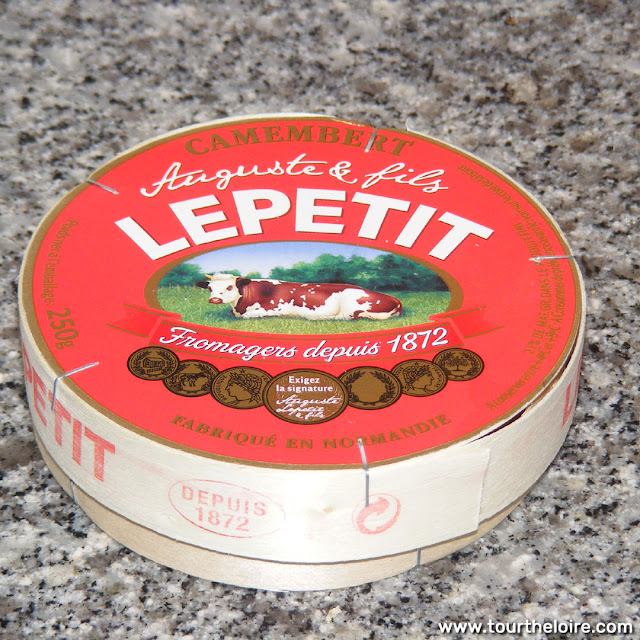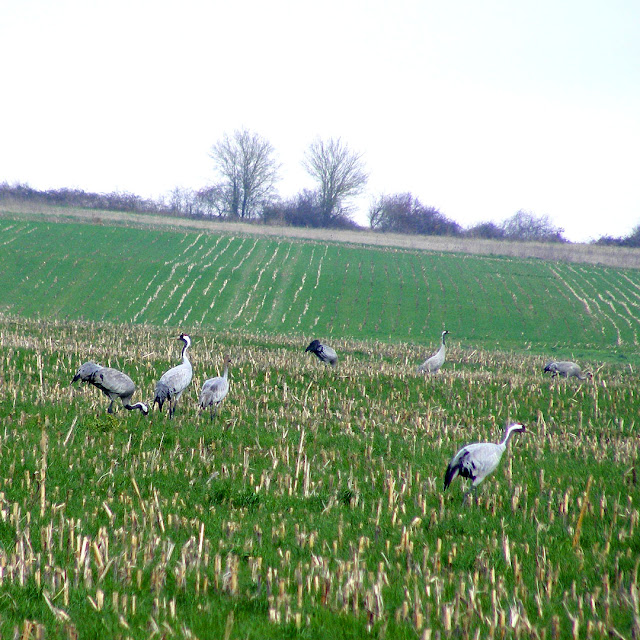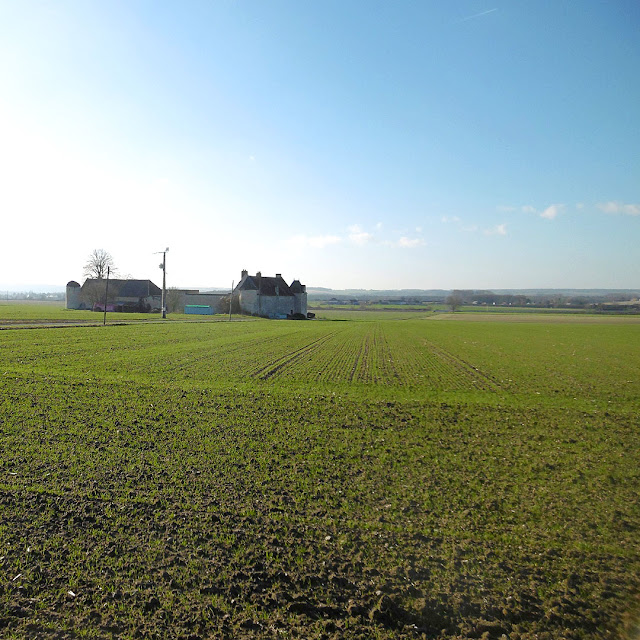Blue Eyes Lacewing Nymphes myrmeleonides are more closely related to antlions than lacewings. They are found in Queensland and New South Wales, Australia. Their white tipped wings have a span of about 11 cm.
Pages
Sunday, 28 February 2021
Saturday, 27 February 2021
Arc de Triomphe
 |
| Photo taken in September 2002. |
The Arc de Triomphe, like all other heritage attractions in France is currently closed to visitors. It is managed by the Centre des monuments nationaux (the Centre for National Monuments).
It sits in the centre of Place de l'Etoile and a notorious multi-lane roundabout at the top of the Champs Elysées. Under normal circumstances you can access it via a pedestrian subway and climb the internal stairs to the top to see the panoramic view over Paris.
The arch was designed to reference and outdo the Roman Emperor Titus' triumphal arch by being a single span that was higher and wider. Although Napoleon Bonaparte had wanted to have it built in 1806, history intervened and it wasn't until 1836 that King Louis-Philippe, a constitutional monarch, was able to have it unveiled. He dedicated the arch to the Revolutionary Armies and the French Empire. In 1921 France's Unknown Soldier was buried under the arch, and remembrance ceremonies are held there several times a year.
Later this year, in the autumn, there will be a project to wrap the Arch in silvery blue fabric and red rope. This installation was conceived by the artist Christo, who has since died, but the authorities have announced their intention to go ahead with the work. There was to have been a simultaneous Christo and Jeanne-Claude retrospective at the Pompidou Centre, but with the dates being all messed up due to Covid19, and the Pompidou Centre about to undergo a massive restoration, I assume that is all off.
We are also on Instagram, so check us out to see a regularly updated selection of our very best photos.
Friday, 26 February 2021
Vale Pierre
Recently I learnt that a fellow member of the botanical and mycology club died of Covid19 in December, aged 90. He was a quiet, modest, kind man, who never pushed himself forward into the limelight. I liked him but had no idea what an amazing person he was until I read his obituary. He'd had a stroke and was in an aged care home in Saint Branch, so I hadn't seen him for a while, quite apart from Covid19.
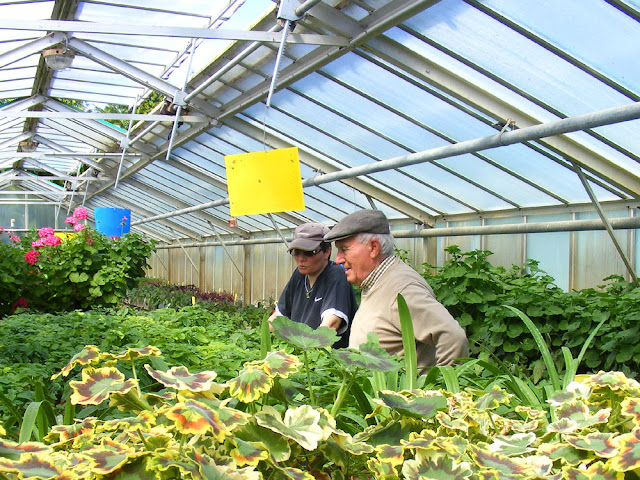 |
| Pierre in 2013, at the City of Tours greenhouses, where he had organised an outing for the Association de Botanique et Mycologie de Sainte Maure de Touraine. |
Abandoned at birth he became a ward of the State and was placed with two successive foster families in Pont de Ruan. He left school at thirteen and a half, like most of the children in State care at the time. His first job was on a farm, then he went to work on a market garden. After that he landed a job at the famous Chateau of Villandry where he spent several years maintaining their magnificent gardens. This on the job training meant that he was recruted in 1953 by the City of Tours to work in the Botanical Gardens, which were part of the Tours School of Medicine and Pharmacy. When the School became a national university in 1963 he stayed in the post.
 |
| Tours Botanical Gardens with the General Hospital beyond. |
Working in all parts of the Botanical Gardens he acquired a solid knowledge of the flora, which allowed him to guide pharmacy students in their botanising, at first in the Touraine, and later in the Alpes grenobloises. He developed a similar passion for mycology and took an active part in the preparations for fungi displays. Working in close collaboration with the successive Medicine and Pharmacy Faculty professors he participated in a number of important projects: re-labelling the species in the Botanical Gardens; editing a catalogue of seed exchanges; creation of a medicinal plants garden; remodelling the Evolution Gardens systematic collections.
 |
| Pharmacy faculty at Tours University. |
In his daily work, with kindness and competence, he commented on this or that plant species, passing on information to scholars, students and ordinary members of the public who were lucky enough to be walking through the garden.
 |
| A young gardener at Villandry, like Pierre would have been. |
Self-taught, having climbed the ladder, he ended his career with the title of Assistant Engineer and received a nomination for an Order of National Merit. When he retired the pharmacy professor at the time said 'Always very helpful, much appreciated by his colleagues, he contributed to the training of hundreds of students and pharmacists who will never forget him'.
He is survived by his son and daughter. His wife died in 2003.
[I've based this post on an obituary written by Marcel Bailly.]
Thursday, 25 February 2021
Protesting Against A Class Closure
 |
| Villagers gathering at the meeting point before setting off on a march. |
Preuilly sur Claise and Yzeures sur Creuse, who together operate our local kindergarten and primary schools, have been threatened by the National Education Service with a class closure and the loss of a teacher at the beginning of the next school year (in September). Every thinking person in town finds this unacceptable and a protest movement is being energetically co-ordinated by the Headmistress and a couple of Mums. But, as the Mayor had to glumly admit, it's probably a done deal, although there is still some negotiations to be conducted as a formality.
 |
| The kids had made banners which were hung up on the school railings. |
The Mayors of the five villages that form the catchment area for these two schools have done their best to put up strong arguments and they've met with everyone they can think of who could influence the decision. Our local representative in the Legislative Assembly, Sophie Auconie, has been great. She came down and visited the school and allowed herself to be subjected to hard questioning from the kids about what was going on. Naturally she has been very supportive of the Mayors as they take the fight higher up the decision making chain. Sadly though, this will be one of her last activities as our Parliamentary Deputy. She has announced her resignation, due to ongoing health concerns after having treatment for breast cancer.
 |
| TVTours interviewing our Mayor. |
On Saturday I attended a march to demonstrate to the authorities how opposed the community is to the class closure, and I'm taking the opportunity to show some of my photos here. The main concern is that it will result in class sizes that are too large, and nobody benefits from that.
It is strongly felt that this move is all about providing extra teachers in the Priority Urban Zones, which was a government promise, but at the expense of rural schools, which the government claimed it would not do. It is also felt that a class closure is the thin edge of the wedge and once a school suffers the loss of a class it is likely to be at risk of closure altogether. (And we in Preuilly should know, as we've seen it happen in the villages around us.)
 |
| Marching up the Grand Rue. |
People are worried that young families won't move into the area if the schools aren't good, and that those who have recently moved here will feel let down. There are concerns about auxiliary services being lost in a knock on effect, such transportation, daycare, the school canteen or the library. It is felt that geographically we are actually in a great position to have fully functioning schools and municipal plans for the future have been based on that.
 |
| The head of the march sets off. |
 |
| We occupied the market place. |
 |
| Photo opp in front of the town hall. |
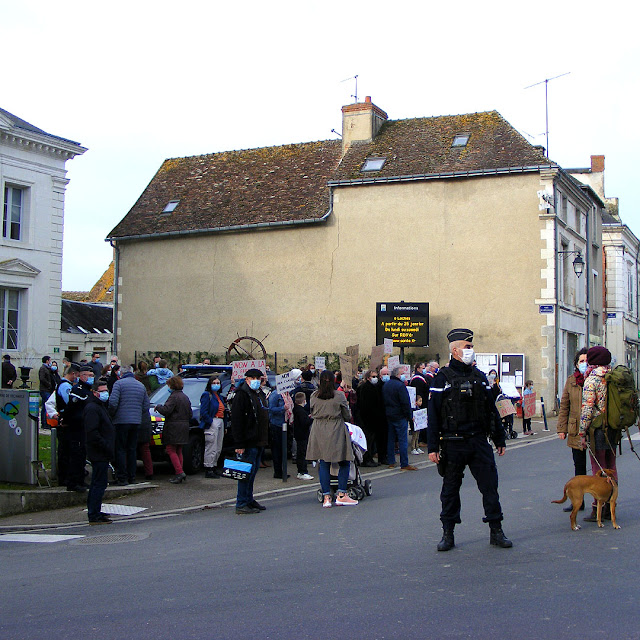 |
| About 10 policemen provided security. |
We are also on Instagram, so check us out to see a regularly updated selection of our very best photos.
Wednesday, 24 February 2021
Poplar Plantations in the Touraine Loire Valley
 |
| Vintage fruit boxes, lovingly preserved by our local organic orchard. |
We are also on Instagram, so check us out to see a regularly updated selection of our very best photos.
Tuesday, 23 February 2021
More than a Doer Upper
This house is close to the road to Chateauroux. I fear it may be too late to save it (and doing so would render some goats homeless).
It amazes me that the countryside and villages are littered with so many empty falling down buildings. Some are little (or not so little) half timbered cottages, some were once elegant townhouses. Sooner or later though, many of them will probably find owners who will love them back into life - if they don't fall down first.
Monday, 22 February 2021
Pot au feu
Pot au feu is an old French classic. Not fine dining by any means, more of a peasant feast. The name simply means 'pot on the fire'. It requires nothing more than cheap bulk ingredients, a knife to chop them up into a big pot and a 'fire'.
Ingredients
About 1.5 kg vegetables -- a mixture of onion, leek, celery or celeriac and carrots
About 1.5 kg stewing beef -- a mixture of short rib, shank and chuck steak
A couple of marrow bones
Parsley, thyme and bay leaves tied up in leek greens to form a bouquet garnie
1/2 tsp black peppercorns
Salt
4 - 5 l water
3 carrots, cut into chunks
A rutabaga, peeled and cut into chunks
4 celery stalks, cut into 5 cm lengths, or a celeriac, peeled and cut into chunks
2 leeks, cleaned and cut into chunks
500 g potatoes, scrubbed and cut into chunks
Method
- Clean, peel and cut the 1.5 kg of vegetables into large chunks.
- Put the vegetables into a large pot, put the meat and marrow bones on top.
- Add the bouquet garnie, peppercorns and some salt (at least a teaspoon).
- Pour the water over and bring to the boil, then reduce the heat and simmer for two and a half hours.
- Pick out the meat and marrow bones with tongs and put aside.
- Strain the stock and put the vegetables aside.
- Put the stock back in the big pot and add the uncooked celery, leeks, rutabaga and carrot, along with the reserved meat.
- Bring to the boil, reduce heat and simmer for half an hour.
- Add the potatoes and simmer for a further 40 minutes.
- Taste for salt and add more if necessary.
- To serve, fish out the meat and vegetables with a slotted spoon and place in soup bowls. Add a couple of ladles of stock.
- Serves 8.
It is not traditional to brown the meat before you add it to the pot, which is one of the ways you can tell it is a very old recipe. However, modern palates are used to the caramelisation you get from the searing process, and there is no reason not to do it if you like (or can be bothered...).
A truly traditional pot au feu would contain generous quantities of turnips. Neither Simon nor I like turnips, so I have deliberately dodged them. I also haven't bothered to peel the potatoes, which a French cook would almost certainly do.
You will be left with lots of beef stock, which you can make onion soup with.
And you will have some very soft cooked vegetables put aside in Step 6. Pick out the peppercorns and puree the vegetables. Add stock until you have a velouté soup consistency. Reheat and serve with croutons.
We are also on Instagram, so check us out to see a regularly updated selection of our very best photos.
Sunday, 21 February 2021
Double White-banded Noctuid Moth
The Double White-banded Noctuid moth Donuca rubropicta is a striking day flying Australian moth. The heavy white bands line up to form continuous bright horizontal stripes when the moth is sitting in its natural resting position. The large eyespots add to the dramatic effect.
In this photo there is a glimpse of the bright scarlet edges of the abdomen and hind wing margin. From wingtip to wingtip the moth is about 5cm across.
We are also on Instagram, so check us out to see a regularly updated selection of our very best photos.
Saturday, 20 February 2021
Eiffel Tower and Australian Embassy
The Eiffel Tower is very conveniently next door to the Australian Embassy in Paris.
We are also on Instagram, so check us out to see a regularly updated selection of our very best photos.
Friday, 19 February 2021
A Master's Window
Driving idly along on one of our Sunday outings, having been to photograph the railway station and wheat silos at La Celle Saint Avant we spotted this marvellous dormer window.
We knew what it was immediately, as we've encountered these highly ornate roof windows before. They are rather uncommon, but there are some wonderful examples in Chateauroux [link] and a few other places. About 300 of them survive in central France and the Loire Valley.
Ones like this, with a square form, are called lucarnes capucines. They are the work of the master craftsmen of the artisan trade guilds in the 19th century. This one was made by a master carpenter-roofer belonging to the Compagnons du Devoir de Liberté. He is demonstrating how skillful he is, as a sort of advertisement. The house it adorns would have been his own home, and young carpenters travelling around France (journeymen) would have understood from this signal that there was a welcome and work for them here.
These special dormers usually carry coded messages to do with the values of the guilds and secret phrases. The arrangement of letters is a code I've seen on several of these windows, but I haven't quite deciphered it yet. I'm fairly sure that the big 'A' will be for 'Arts', and the big 'D' for 'Devoir' (duty/work). 'INCD' within the crossed compasses I can't yet interpret. On the pediment, and tucked in under the complex woodwork are other letters and numbers, not all of which I can read. The central star on the pediment is likely to be a secret guild sign for the Seal of Solomon.
Sadly, this lucarne capucine is not in very good condition and vulnerable to deterioration.
We are also on Instagram, so check us out to see a regularly updated selection of our very best photos.
Thursday, 18 February 2021
Cranes Feeding in the Fields
The other day we went to Chateauroux, and just outside of Azay le Ferron we spotted a flock of Common Cranes Grus grus (Fr. Grues cendrées). They were feeding together in fields that were fallow for the winter. There were adults and juveniles together, so presumably a number of family groups making up a bigger flock. They may have been from the population that overwinters in the Brenne, but they might have been taking a rest from their northward migration, which happens about now every year. Huge numbers of cranes are on the move, from the weekend onwards, coming up the Atlantic coast then crossing the country from west to east, heading for Germany.
France is particularly important for the Common Crane population, with a number of important overwintering sites and lots of sites where they stop to rest and refuel whilst on migration.
If you get a close enough view of them (they are rather wary of vehicles and humans) you can see that they have a white stripe along the neck and a darker grey drooping tuft of feathers that form the tail. If the light is good enough you can see the top of the adults heads are red and bald.
In the winter they will be mainly eating seeds left in the field from the previous summer's crops.
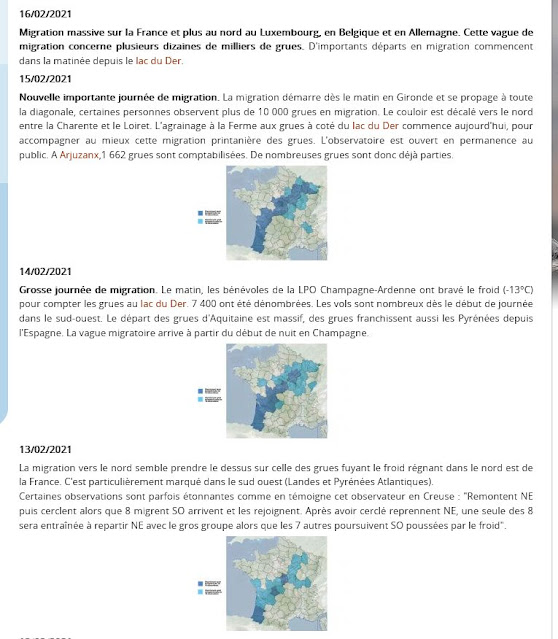 |
| "Massive migration over France, and further north in Luxembourg, Belgium and Germany. This migration wave involves tens of thousands of cranes." [Screen shot courtesy of Tim Ford.] |
We are also on Instagram, so check us out to see a regularly updated selection of our very best photos.
Wednesday, 17 February 2021
Manoir de la Chetalliere
The Manor of La Chetallière is an ancient fiefdom near Maillé, once owing allegiance to Nouâtre. The Lord of La Chetallière had to provide eight days guard duty at the castle of Nouâtre annually.
A deed from 1678 indicates that the manor was fortified with high walls and gun ports to defend the entrance.
In 1614 it was owned by a local squire. By 1689 it was owned by Jean Daguindeau, Provost to the Marshals of France, who was based in Chinon.
The estate was seized and sold as State Property in 1796, after the owner, N du Puy, fled the Revolution and became an emigre.
Today it is just an ordinary grain farm.
We are also on Instagram, so check us out to see a regularly updated selection of our very best photos.
Tuesday, 16 February 2021
Chateau d'Argenson
The Chateau d'Argenson is near Maillé. The sad history of the village which was the victim of a Nazi war crime in the Second World War is well known locally [link], but the grand past of the Chateau d'Argenson is barely known, even to the locals. It is privately owned and not open to the public.
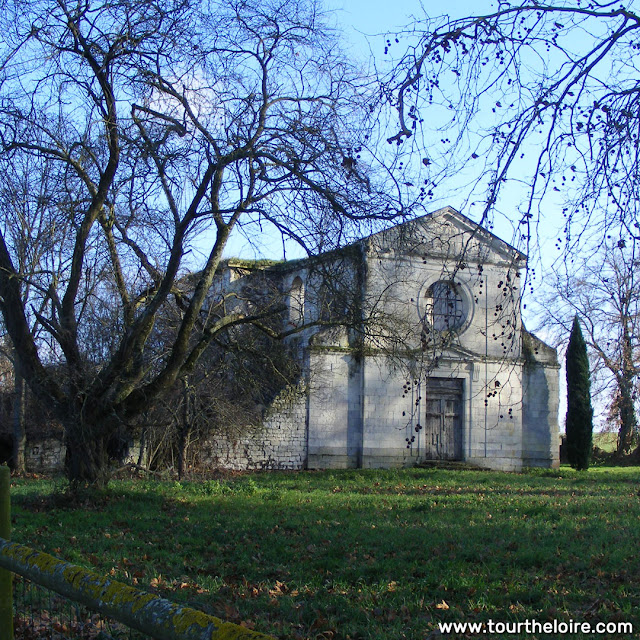 |
| The church. |
In the 15th century, in the reign of Charles VII, the estate belonged to the Lord of Nouatre, Jean Gueffault, but in the 16th century the heir was a woman, and the estate passed to her husband Jean III Voyer de Paulmy. They were the grandparents of René, Comte d'Argenson. His son René II de Voyer de Paulmy, former Ambassador to Venice, rebuilt the chateau in the 17th century, despite opposition from the powerful Prince de Rohan, Lord of Sainte Maure.
 |
| The old part of the chateau is currently under scaffolding. |
 |
| The charming garden gate to the home farm. |
In the chateau complex is the main residential block, a church, a presbytery, two pavillions and a dovecote. In 1667 the private chapel on the site was replaced with the current classical style parish church. The transepts formed two chapels, but only the northern one survives. In 1678 another chapel was added, where René de Voyer was buried. The presbytery is behind the church, and a small building with arcades referred to as an auditorium, is now bookended by ugly metal farm buildings at the entrance. The auditorium served as a courthouse. The chateau was begun at much the same time, but never finished. It consists of a central block, with a wing which extends to the north. A wing to the south, and another central block to the east were planned but never constructed. There is a sundial carved directly into the eastern facade. The two pavillions served as staff accommodation and stables. The cylindrical dovecote dates from 1683.
 |
| The chateau. |
Once upon a time the chateau complex stood in a park of a hundred hectares. Almost all the trees have gone and the land ploughed up for crops, but the long perimeter wall survives, a bit battered and covered in ivy, all around the chateau and its associated buildings. At the entrance is the rather picturesque home farm complex.
 |
| The view from the front entrance, with the two pavillions on either side, and the end of the chateau in the middle. |
The church has had no roof for more than fifty years, and these days is just a rather sad ruin.
 |
| One of the pavillions. |
The chateau appears strangely isolated, surrounded by cultivated fields. What we see today is just what remains after significant demolitions in the 18th century. Despite having two sections dating from quite different periods, it does retain a surprisingly homogenous and classical look. The southern half is the only remaining vestige of the 15th century chateau on the site, which formed a quadrangle, with corner towers and a moat. It does not conform to the vision René de Voyer originally had, and in 1729 Marc-Pierre d'Argenson bought the Chateau des Ormes. The Argenson estate was rented out and the chateau abandoned. For more than two centuries the building was subjected to demolitions, doors and windows destroyed, panelling removed, stone flags lifted, the park obliterated. Open to the elements it became a ruin.
Luckily the last Argenson descendant to own the estate, Thérese de Goulaine, and her husband Anne-Francois d'Harcourt wanted to restore it and from 1959 they have succeeded in saving the building. It is now watertight and habitable, with their son Olivier managing the continuing restoration.
We are also on Instagram, so check us out to see a regularly updated selection of our very best photos.
Monday, 15 February 2021
A Conversation About Bread
 |
| Buying a baguette at a vending machine. |
Recently I had the pleasure of having a conversation about bread with Annie Sargent from Join us in France. Annie recorded it as one of her weekly podcasts, and you can listen to it here [link].
To read the notes I made for Annie to guide the conversation click here [link].
 |
| Organic bread at the market. |
We are also on Instagram, so check us out to see a regularly updated selection of our very best photos.
Sunday, 14 February 2021
The Pilliga Scrub
I have been missing going for a drive. Although there are currently very few restrictions on movement here (apart from having to be home by 6.00pm) we haven't been out much the past 11 months. We have had one trip to the coast in June (about 200km each way), but no day long drives - not even day long driving tourists for work.
I am so missing driving that I would even probably put up with driving through the Pilliga Scrub. Usually I hate it. It feels like driving past the same tree seventy-billion-trillion times. But at the moment?
Maybe...
Saturday, 13 February 2021
All the Water in the World
Thirty years ago I was in South America with my mate Hugo. One of the exciting places we visited was the Iguacu Falls, the largest waterfall (by some metrics) in the world. You may recognise it as the setting for the film "The Mission".
We
visited the Brazilian side of the falls the first day we were there
(no, we didn't take a helicopter under the falls - need you ask?):
...and
the Argentinian side the second day. On both sides there is a series of
concrete walkways out into the middle of the river above the falls.
When we visited these were in a quite scary state. Can you tell?
Although we didn't visit, we could also see Paraguay from our hotel. That's Argentina in the foreground, Brazil in the centre, and behind that Paraguay.
I have dozens of photos of the Iguacu Falls. I hope these give an idea of what it's like...
Thursday, 11 February 2021
Chateau de la Tourballiere
The chateau of Tourballiere, a few kilometres from La Celle Saint Avant, is in fact two (or maybe three) chateau, in a row, visible from the D109 road, and all ruined. Their position looking out from the edge of the forest, and their general aspect is atmospheric and eery.
 |
| 18th century farm building to the left of the chateaux. |
Of the U or H-shaped 18th century chateau rebuilt for Paul de Murat, only the front facade survives. The side wings are long gone. The central part is deceptively well preserved, with a double colonnade topped by a crumbling pediment decorated with two lions in a coat of arms.
 |
| The ruined facade of the chateau. |
La Tourballiere is an old lordship, but we don't know anything about it until 1495, when it was in the possession of the Philippe family. At the beginning of the 18th century it was acquired by the powerful and ubiquitous Voyer d'Argenson family. In the late 18th or early 19th century their chateau was rebuilt by Paul de Murat, and the old manor remodelled.
 |
| The ruined manor house. |
The chateau was still in a good state of repair in the early 20th century, as shown by postcards of the period. After that, it seems there was a lack of maintenance, resulting in it being a ruin by the 1980s, and the gardens converted to agricultural land. [Note: there was a fire in 1930 which left it in this state.]
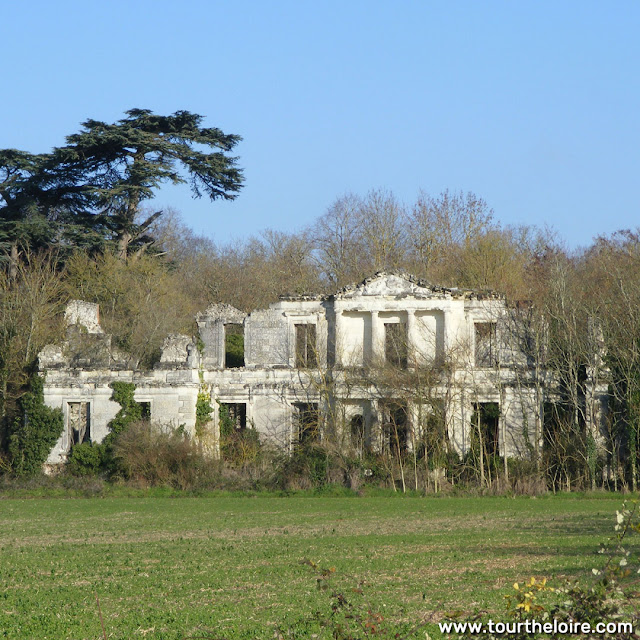 |
| The ruined facade of the chateau. |
The 17th century owner was the Marquis de Chamberet, who also controlled Le Chatelier at Paulmy. In 1670 he took the local priest to court for having smashed up the family tomb in the church at La Tourballiere. The court case dragged on, but sadly the records do not reveal the outcome! The explanation for the priest's behaviour is of course that Chamberet was Protestant. His grandfather was Francois de la Noue, one of Henri IV's boon companions and known as Iron-Arm because he had lost an arm and used a metal prothesis.
 |
| The manor house. |
When Chamberet went into exile after the repeal of the Edict of Nantes it allowed Marc René Voyer d'Argenson to acquire the property. His daughter married Paul de Murat, bringing the property as dowry.
 |
| The complex as seen from the D109 roadside. |
To the left of the two chateaux is a third big building. It seems to be a farm building, in better condition than the other two, but I can't find out anything about it. [Note: it is an outbuilding associated with the 18th century chateau. The vaulted alcoves may be to shelter horses, carts or carriages.]
 |
| 18th century farm building. |
 |
| Central block of the farm building. |
 |
| The burned out chateau ruin. |
Update: On 17 March 2021 I received an email from my friend André, who passed on some information from Catherine Puglia, the guide at the Chateau des Ormes. It seems that the beginning of the 20th century the property was sold to a developer, who bought it for the land. In 1930, there was a fire which ravaged the chateau, and afterwards it was left in that state so as to avoid paying taxes on it.
Also, we now think the building on the left with the large pointed alcoves might have been a coach house. Catherine is of the opinion that the alcoves might have been to shelter horses.
She has asked that I make it clear that this is private property and unauthorised access is prohibited. The property is in a dangerous state and people should not enter and explore.
We are also on Instagram, so check us out to see a regularly updated selection of our very best photos.




